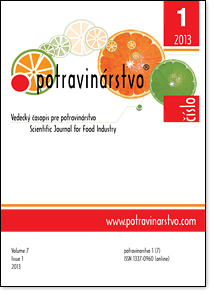Preparation and characteristics of beta-glucan concentrate from brewer's yeast as the additive substance in foods
DOI:
https://doi.org/10.5219/258Keywords:
Saccharomyces cerevisiae, brewer's yeast, β-glucan, antioxidative activityAbstract
The brewer¢s yeast was used for preparation of concentrate with content of β-glucan. Hot water extraction (100°C, 5 hours) and subsequently an alkaline extraction of sediment using 1 M NaOH at 90°C for 1 hour were used. β-glucan concentrate containing 59,15 % of β-glucan had good functional properties (water binding capacity 13,34 g water/1 g concentrate, fat binding capacity 6,86 g fat/1 g concentrate) and indicated biological action too. At concentration of 2 mg/ml DMSO (dimethylsulfoxid) was viability of murine L1210 leukemic cells reduced to 76.15 %. When observing the antioxidant activity it was identified, that the lipid peroxidation in linoleic acid samples was decreased during the presence of β-glucan concentrate. These results and good sensory properties like a bright colour and the pleasant taste and smell indicate, that prepared β-glucan concentrate has a potential to be used to improve the health – beneficial substances in the foods.
Downloads
Metrics
References
Ahmad, A., Anjum, F. M., Zahoor, T., Nawaz, H., Ahmed, Z. 2010. Extraction and characterization of β-D-glucan from oat for industrial utilization. International Journal of Biological Macromolecules, vol. 46, p. 304-309. https://doi.org/10.1016/j.ijbiomac.2010.01.002 PMid:20083136 DOI: https://doi.org/10.1016/j.ijbiomac.2010.01.002
Andrews, S. R., Sahu, N. P., Pal, A. K., Mukherjee, S. C., Kumar, S. 2011. Yeast extract, brewer′s yeast and spirulina in diets for Labeo rohita fingerlings affect haemato-immunological responses and survival following Aeromonas hydrophila challenge. Research in Veterinary Science, vol. 91, p. 103-109. https://doi.org/10.1016/j.rvsc.2010.08.009 PMid:20825959 DOI: https://doi.org/10.1016/j.rvsc.2010.08.009
Azizah, A. H., Nik Ruslawati, N. M., Swee Tee, T. 1999. Extraction and characterization of antioxidant from cocoa by-products. Food Chemistry, vol. 64, p. 199-202. https://doi.org/10.1016/S0308-8146(98)00121-6 DOI: https://doi.org/10.1016/S0308-8146(98)00121-6
Carmichael, J., Degraff, W. G., Gazdar, A. F., Minna, J. D., Mitchell, J. B. 1987. Evaluation of a tetrazolium-based semiautomated colorimetric assay: assessment of chemosensitivity testing. Cancer Research, vol. 47, 1987, p. 936-942. PMid:3802100
Dietrich-Muszalska, A., Olas, B., Kontek, B., Rabe-Jablońska, J. 2011. Beta-glucan from Saccharomyces cerevisiae reduces plasma lipid peroxidation induced by haloperidol. International Journal of Biological Macromolecules, vol. 49, p. 113-116. https://doi.org/10.1016/j.ijbiomac.2011.03.007 PMid:21421004 DOI: https://doi.org/10.1016/j.ijbiomac.2011.03.007
Ferreira, I. M. P. L. V. O., Pinho, O., Vieira, E., Tavarela, J. G. 2010. Brewer′s saccharomyces yeast biomas: characteristics and potential applications. Trend in Food Science & Technology, vol. 21, p. 77-84. DOI: https://doi.org/10.1016/j.tifs.2009.10.008
Freumund, S., Sauter, M., Käppeli, O., Dutler, H., 2003. A new non-degrading isolation process for 1,3-β-D-glucan of high purity from baker′s yeast Saccharomyces cerevisiae. Carbohydrate Polymers, vol. 54, p. 159-171. https://doi.org/10.1016/S0144-8617(03)00162-0 DOI: https://doi.org/10.1016/S0144-8617(03)00162-0
Giavasis, I., Biliaderis, C. G. 2006. Microbial Polysaccharides. BILIADERIS, C. G. & IZYDORCZYK, M. S. Functional Food Carbohydrates. 1. vyd. CRC Press Int.: London, p. 176-200. ISBN-10: 10:0-8493-1822-X.
Hoseinifar, S. H., Mirvaghefi, A., Merrifield, D. L. 2011. The effects of dietary inactive brewer′s yeast Saccharomyces cerevisiae var. ellipsoideus on the growth, physiological responses and gut microbiota of juvenile beluga (Huso huso). Aquaculture, vol. 318, p. 90-94. https://doi.org/10.1016/j.aquaculture.2011.04.043 DOI: https://doi.org/10.1016/j.aquaculture.2011.04.043
Jaehrig, S. C., Rohn, S., Kroh, L. W., Wildenauer, F. X., Lisdat, F., Fleischer, L. G., Kurz, T. 2008. Antioxidative activity of (1→3), (1→6)- β-D-glucan from Saccharomyces cerevisiae grown on different media. LWT, vol. 41, p. 868-877. DOI: https://doi.org/10.1016/j.lwt.2007.06.004
Magnani, M., Calliari, C. M., Macedo Jr., F. C., Mori, M. P., Cólus, I. M. S., Castro-Gomez, R. J. H. 2009. Optimized methodology for extraction of (1→3)(1→6)-β-D-glucan from Saccharomyces cerevisiae and in vitro evaluation of the cytotoxicity and genotoxicity of the corresponding carboxymethyl derivate. Carbohydrate Polymers, vol. 78, p. 658-665. https://doi.org/10.1016/j.carbpol.2009.05.023 DOI: https://doi.org/10.1016/j.carbpol.2009.05.023
Mantovani, M. S., Bellini, M. F., Angeli, J. P. F., Oliviera, R. J., Silva, A. F., Ribeiro, L. R. 2008. β-glucan in promoting health: Prevention against mutation and cancer. Mutation Research/Reviews in Mutation Research, vol. 658, p. 154-161. https://doi.org/10.1016/j.mrrev.2007.07.002 PMid:17827055 DOI: https://doi.org/10.1016/j.mrrev.2007.07.002
Pedroche, J., Yust M. M., Lqari, H., Cirón-Calle, J., Alaiz, M., Vioque, J., Millán, F., 2004. Brassica carinata protein isolates: chemical composition, protein characterization and improvement of functional properties by hydrolysis. Food Chemistry, vol. 88, p. 337-346. https://doi.org/10.1016/j.foodchem.2004.01.045 DOI: https://doi.org/10.1016/j.foodchem.2004.01.045
Piotrowska, A., Waszkiewicz-Robak, B., Świderski, F., 2009. Possibility of β-glucan from spent brewer′s yeast addition to yogurts. Polish Journal of Food and Nutrition Sciences, vol. 59, p. 99-302.
Santipanichwong, R., Suphantharika, M. 2009. Influence of different β-glucan on the physical and rheological properties egg yolk stabilized oil-in-water emulsions. Food Hydrocolloids, vol. 23, p. 1279-1287. https://doi.org/10.1016/j.foodhyd.2008.10.006 DOI: https://doi.org/10.1016/j.foodhyd.2008.10.006
Satrapai, S., Suphantharika, M. 2007. Influence of spent brewer′s yeast β-glucan on gelatinization and retrogradation of rise starch. Carbohydrate Polymers, vol. 67, p. 500-510. https://doi.org/10.1016/j.carbpol.2006.06.028 DOI: https://doi.org/10.1016/j.carbpol.2006.06.028
Soares, E. V., Soares, H. M. V. M. 2012. Bioremediation of industrial effluents containing heavy metals using brewing cells of Saccharomyces cerevisiae as a green technology: a review. Environmental Science & Pollution Research, vol. 19, p. 1066-1083. https://doi.org/10.1007/s11356-011-0671-5 PMid:22139299 DOI: https://doi.org/10.1007/s11356-011-0671-5
Suphantharika, M., Khunrae, P., Thanardkit, P., Verduyn, C. 2003. Preparation of spent brewer′s yeast β-glucans with a potential application as an immunostimulant for black tiger shrimp, Penaeus monodon. Bioresource Technology, vol. 88, p. 55-60. https://doi.org/10.1016/S0960-8524(02)00257-2 DOI: https://doi.org/10.1016/S0960-8524(02)00257-2
Velíšek, J. 1999. Chemie potravin 1. 1. vyd. OSSIS : Tábor, 328 p., ISBN 80-902391-3-7.
Worrasinchai, S., Suphantharika, M., Pinjai, S., Jamnong, P. 2006. β-glucan prepared from spent brewer′s yeast as a fat replacer in mayonnaise. Food Hydrocolloids, vol. 20, p. 68-78. https://doi.org/10.1016/j.foodhyd.2005.03.005 DOI: https://doi.org/10.1016/j.foodhyd.2005.03.005
Zechner-Krpan, V., Petrović-Tominac, V., Galović, P., Galović, V., Filipović-Grčić, J., Srečec, S. 2010. Application of different drying methods on β-glucan isolated from spent brewer′s yeast using alkaline procedure. Agriculturae Conspectus Scientificus, vol. 75, 2010, p. 45-50.
Downloads
Published
How to Cite
Issue
Section
License
This license permits non-commercial re-use, distribution, and reproduction in any medium, provided the original work is properly cited, and is not altered, transformed, or built upon in any way.






























